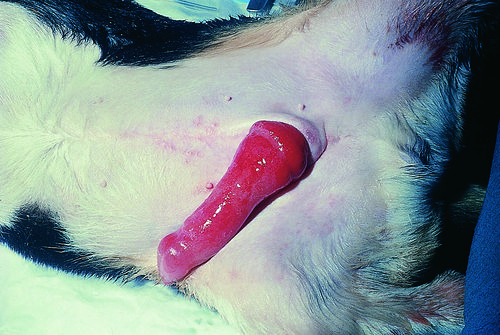Small Animal Soft Tissue Surgery Q&A 05
| This question was provided by Manson Publishing as part of the OVAL Project. See more Small Animal Soft Tissue Surgery Q&A. |
This dog was presented for persistent erection. The penis cannot be reduced into the prepuce. No other physical abnormalities were found on examination.
| Question | Answer | Article | |
| What are the causes of this condition? | Paraphimosis, the inability to retract the erect penis following sexual stimulation, may be caused by:
|
Link to Article | |
| What is the treatment for each of the above causes? | Paraphimosis is treated by cleaning and lubricating the penis and replacing it in the prepuce. Application of hyperosmolar solutions or warm packs are useful for shrinking the penis to facilitate replacement. For phimosis, surgical enlargement of the preputial orifice or partial penile amputation may be required to prevent recurrence. Strangulation is treated by removing the strangulating object and treatment of the traumatized ischemic tissues. Catheterization may be needed to ensure urethral patency until resolution of penile edema. The pathogenesis of priapism in man and dogs is not currently understood and treatment is limited. Treatment must be prompt and consists of preventing drying and self-trauma, and addressing the inciting cause (e.g. spinal fracture fixation). Injection of alpha-adrenergic drugs or benztropine, and anticholinergic drugs, into the corpus cavernosum penis to induce detumescence has been reported in man and a stallion. Surgical treatment in man is by creating a communication between the corpus cavernosum penis and the glans penis, and this may be an option in breeding animals. Potential sequelae to chronic penile prolapse include penile necrosis and urethral obstruction. In these cases, partial or complete penile amputation is indicated. |
Link to Article | |
